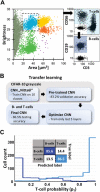AIDeveloper: Deep Learning Image Classification in Life Science and Beyond
- PMID: 34105281
- PMCID: PMC8188199
- DOI: 10.1002/advs.202003743
AIDeveloper: Deep Learning Image Classification in Life Science and Beyond
Abstract
Artificial intelligence (AI)-based image analysis has increased drastically in recent years. However, all applications use individual solutions, highly specialized for a particular task. Here, an easy-to-use, adaptable, and open source software, called AIDeveloper (AID) to train neural nets (NN) for image classification without the need for programming is presented. AID provides a variety of NN-architectures, allowing to apply trained models on new data, obtain performance metrics, and export final models to different formats. AID is benchmarked on large image datasets (CIFAR-10 and Fashion-MNIST). Furthermore, models are trained to distinguish areas of differentiated stem cells in images of cell culture. A conventional blood cell count and a blood count obtained using an NN are compared, trained on >1.2 million images, and demonstrated how AID can be used for label-free classification of B- and T-cells. All models are generated by non-programmers on generic computers, allowing for an interdisciplinary use.
Keywords: artificial intelligence; deep neural networks; graphical user interface; image processing; software.
© 2021 The Authors. Advanced Science published by Wiley-VCH GmbH.
Conflict of interest statement
The authors declare no conflict of interest.
Figures




References
-
- Nitta N., Sugimura T., Isozaki A., Mikami H., Hiraki K., Sakuma S., Iino T., Arai F., Endo T., Fujiwaki Y., Fukuzawa H., Hase M., Hayakawa T., Hiramatsu K., Hoshino Y., Inaba M., Ito T., Karakawa H., Kasai Y., Koizumi K., Lee S., Lei C., Li M., Maeno T., Matsusaka S., Murakami D., Nakagawa A., Oguchi Y., Oikawa M., Ota T., Shiba K., Shintaku H., Shirasaki Y., Suga K., Suzuki Y., Suzuki N., Tanaka Y., Tezuka H., Toyokawa C., Yalikun Y., Yamada M., Yamagishi M., Yamano T., Yasumoto A., Yatomi Y., Yazawa M., Di Carlo D., Hosokawa Y., Uemura S., Ozeki Y., Goda K., Cell 2018, 175, 266. - PubMed
Publication types
MeSH terms
Grants and funding
LinkOut - more resources
Full Text Sources
